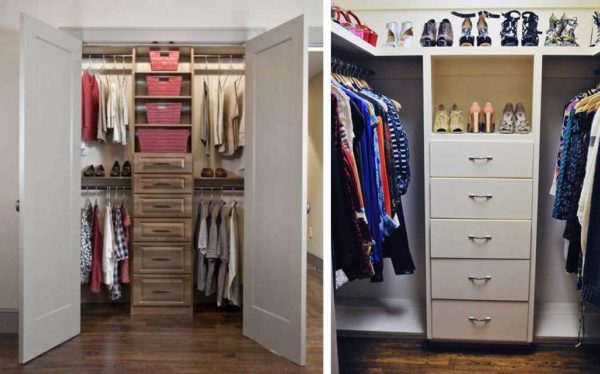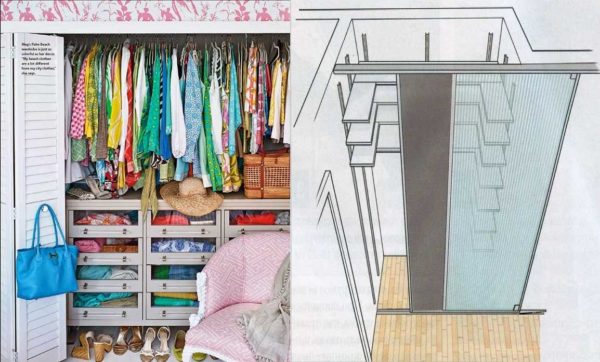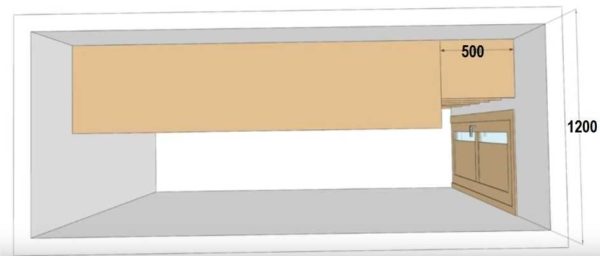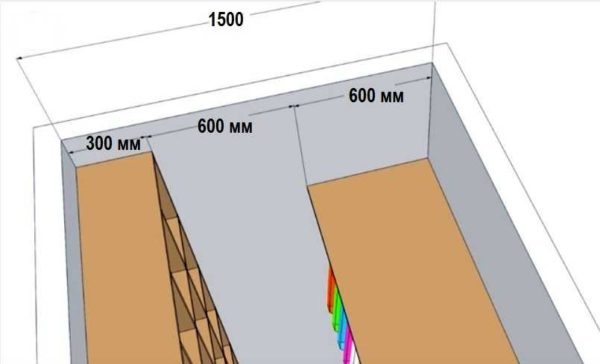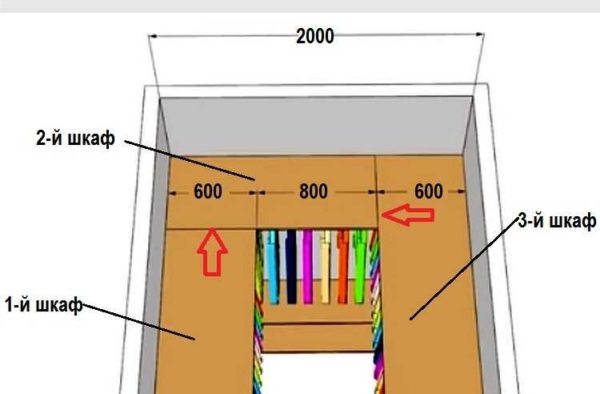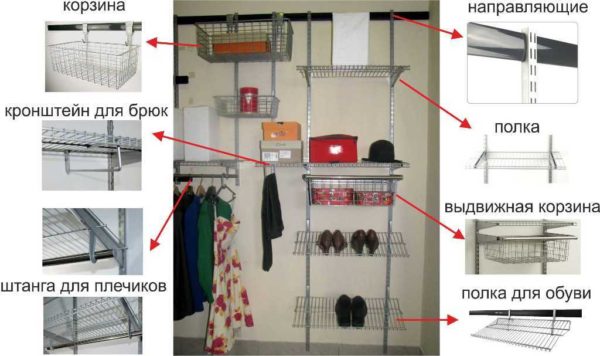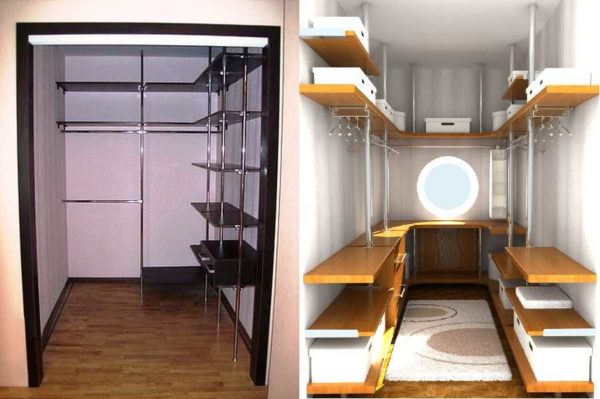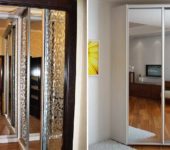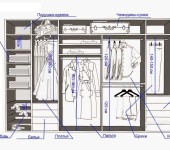How to make a dressing room from a pantry
Modern trends in interior design provide for a minimum amount of furniture. Only what you can't do without. Therefore, wardrobes, wardrobes and other cabinet furniture disappear, and all things are placed in special rooms - dressing rooms. Moreover, for its equipment it is not necessary to have a large space. Even the pantry can be converted. How to equip a dressing room in a pantry - in the article.
The content of the article
Pantry Transformation: Procedure
Turning a pantry into a dressing room is not very difficult - the walls, floor, ceiling are already there. Usually only doors need to be replaced. They, most often, are changed to sliding ones, but ordinary swing ones are also not bad. The rest of the room is just being renovated. Repairs can be done using inexpensive materials, and the main amount can be spent on filling the dressing room. Such distribution of funds will be more reasonable, since it is the shelves-cabinet-drawers that provide convenience, and not the walls trimmed with expensive materials.
The order of work when turning a pantry into a dressing room is as follows:
- We remove everything that is in the pantry. All shelves, hooks, furniture, if any.
- We dismantle the doors and the door frame. At this stage, it is necessary to decide whether the doors will be of the same width or whether the doorway should be expanded, in addition, they will be swing or sliding.
- Next, you need to decide exactly how you will repair the walls in the future dressing room.
- If the walls are very crooked, problems may arise when installing cabinets. In this case, it is better to knock down the old plaster, plaster everything on the lighthouses, finally alignputty.
- If the walls are relatively flat, without large differences (up to 1 cm), you can do only with plaster, after removing the finishing materials (whitewash, the paint is cleaned to clean plaster).
- Another option is to simply refresh the finish: stick wallpaper, paint, and correct all irregularities when installing equipment (an option for those who can find a way out of any situation, since there will be a lot of trouble).
- We are fixing the ceiling. It's usually dyed or bleached, so it's usually just a freshen up finish.
- We install new doors.
- Next, we put in order the floor. Refresh the paint or lay linoleum, you can use vinyl tiles... It makes no sense to use more expensive materials.
The closet in the closet is 50% done. Repair work is over, you can start filling the dressing room. This is where the nuances begin, since the "content" depends on the location of the dressing room and the things that you plan to store in it.
Dressing room width and door arrangement
As already mentioned, the doors to the dressing room can be swing or sliding. Sliding ones are good because they take up little space when open. With a sufficient width of the doorway, they can be double-leafed (or even three-leafed), when opening, one part can "drive in" on the second, or all can move to a free section of the wall nearby.
The closet in the pantry may also have swing doors. They are not as comfortable, but they cost less. If you decide to install swing doors, you need to think over the place of their installation, take into account ease of use and safety.
In general, it is more convenient if the doors to the dressing room are sliding (such as a compartment) and wide. If the storage system is built "from scratch", the doors are most often made in the entire width of the room and it is the sliding system.In closets, the doors are often narrow - 60-70 cm. Making swing doors much wider is hardly worth it, as this "eats up" the useful space.
In a narrow dressing room
A little about where the swing doors should be located if the dressing room in the pantry has a small width. If the room is 135-145 cm wide, the best option for installing swing doors is 10 cm from the left wall, opening inward. Taking into account the installation of the platband 5 cm wide, a gap of 5 cm wide will remain to the wall.This looks normal and on the right there is a 55 cm wide space in which the storage area is equipped - shelves / hangers. But it is realized in rooms with a width of at least 135 cm.
If the width of the closet is even smaller - about 130-120 cm wide, you can move the doors close to the wall or even remove the platband from the side of the dressing room. It's not technologically advanced and not very pretty, but usability is much more important.
So that with such a layout, things do not interfere with closing / opening doors, a shelf zone is installed at the entrance, the width of which is 30-40 cm.Here you can store shoes in boxes, place boxes for underwear and small things, shelves for sweaters / jumpers, etc. Then you can already arrange a storage area on hangers 60 cm wide.
With an average width
With the width of the dressing room in the closet from 150 cm, you can arrange a two-sided storage system - to the right and left of the entrance. In this case, the doors are positioned so that on one side there is a distance of 55 cm to the wall (taking into account the installation of the door frame and casing, it will turn out to be 60 cm). Here you can place an area with hangers. On the other hand, make shelves 30 cm wide in the entire wall.
This layout is maintained up to the width of the room of 175 cm. In this case, another arrangement simply does not work. So if your closet in the closet is 150-175 cm wide, just change the width of the shelves, leaving a 60 cm wide aisle. By the way, if the tenants are large, you can leave the width of the shelves the same, and increase the passage. In this case, a larger person will be more comfortable.
For wider storage areas
With a width of 175 cm and more, you can place hangers on both sides, taking 60 cm to the right and left under them. In this case, a pipe for storing things on hangers is placed at a height of 200-210 cm, a wide shelf is made above it to accommodate oversized and rarely used items (spare pillows / blankets, suitcases, out-of-season clothes).
At a height of 50-60 cm, shelves or boxes for storing things, shoes are installed under the hangers. With this option, the doors usually open outward. Otherwise, when open, they block access to part of the clothing. But, if the dressing room goes into a narrow or dark room (a corridor, for example), the doors should open outward. Because there is a high probability that forgetting to close the doors, you can crash your forehead against the end of the slightly open door. This is much worse than inconvenience.
With a dressing room width of 2 meters or more, you can already do three-sided placement of things. For this, three overlapping cabinets are made - one cabinet overlaps the other. In this case, the area on the left is made shorter, a second cabinet is placed, the length of which is 60 cm shorter than the width of the pantry. And only the area to the right of the entrance takes up space from one wall to another (see the picture above).
Why should you do this? Because if you are right-handed, then in order to get to things located in the overlapping area of the cabinets (in the corners), you will need to move things away and it is more convenient to do this with your right hand. Left at this time you will remove the desired hanger. On the contrary, for a right-handed person it is inconvenient to do it.
Location of the pantry / dressing room and its filling
Filling for wardrobes - shelves, pipes for hangers, drawers and some other special devices such as hangers for trousers, skirts, ties.These fixtures help you use space efficiently, but are expensive. Therefore, with a limited budget, a dressing room in the pantry will do just fine with standard filling.
Near the front door
If your closet closet is near the front door, it will most likely contain seasonal clothes and shoes, hats, gloves, etc. In this case, the filling is selected accordingly. You will need a pipe to hang your outerwear. The height of this compartment is 3/4 of the height of the owners. If space permits, you can provide storage space for jackets, jackets and other similar clothing. The height of this compartment is 1/2 of the height of the "users". In the lower part, there is always a place for shoes. Here it is stored without boxes, so you need to come up with some accessories (do not forget about the section for boots with long tops).
In the upper part of the small dressing room at the entrance, shelves are made for storing hats. Small bags can also be sent there. You will also need a couple of boxes for small items and haberdashery. If there is room left, you can set aside a long, narrow compartment for storing umbrellas.
In the bedroom
If one of the walls of the former pantry goes into the bedroom, the filling in the dressing room from the pantry is selected differently. For the most part, the entire seasonal wardrobe will be located here - everything that is being worn at the moment. Therefore, more branches are required. For dresses, suits, skirts and trousers, you need compartments with hangers. With sufficient ceiling height (2.5 - 2.7 m), you can position two compartments for storing things on hangers: one above the other. In the lower part, you can install a regular pipe, in the upper part, a pantograph will be more convenient. A pantograph is a pipe equipped with a mechanism that allows it to be lowered and raised.
A compartment with a descending pipe is more convenient to do on the side wall, but only if the width of the former closet allows the pantograph to be lowered. If not, move this department to the wall opposite the entrance.
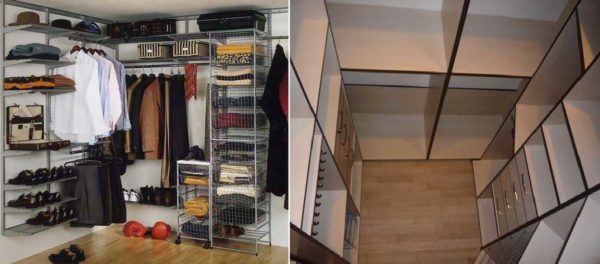
Cloakroom in closet: wire drawers and shelves or pieces Chipboard
For a small dressing room in the closet, the wall of which opens onto the bedroom, it is worth installing several open shelves under the folded things - jumpers, sweaters, T-shirts, etc. Wire drawers or shelves are less cumbersome and more convenient. They save space, moreover, it is better to see what is in these boxes / shelves.
You will definitely also need boxes for linen, a sock and other similar small things. They can also be wired, but this does not affect convenience. Perhaps some people will even be uncomfortable that the laundry is visible even with the drawer closed.
With a large number of shoes, all of them do not fit near the front door. Then you need more shelves for shoes. But usually shoes are stored here, which are not often worn, therefore they are placed in boxes. To place them, ordinary shelves with a width of 35-45 cm are suitable. In this case, all the boxes will be in sight and it will be convenient to get them out. To reduce the cost of the project, instead of shelves, you can strengthen two pipes on which the boxes will be placed. It is convenient, inexpensive, and everything is clearly visible.

